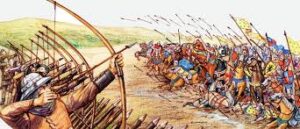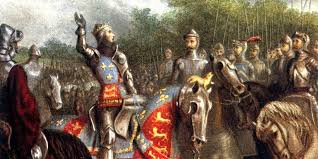Your basket is currently empty!
A Historic Clash in the Hundred Years’ War
The Battle of Agincourt, fought on October 25, 1415, is one of the most famous battles of the Hundred Years’ War between England and France. Despite being heavily outnumbered, King Henry V led the English army to a stunning victory against French forces. This battle became legendary for its unexpected outcome and the revolutionary use of the English longbow.
The Context: England vs. France in 1415
At the time, England and France were locked in a prolonged conflict known as the Hundred Years’ War. Henry V had recently launched a military campaign to claim his rights to the French throne. The English army, exhausted after a tough march, faced a French force nearly three times larger. The stakes were high — a decisive victory could change the balance of power in medieval Europe.
The Battlefield and Tactics
The battle took place on a narrow, muddy field near the village of Agincourt in northern France. The English used the terrain to their advantage, positioning themselves between two dense forests. This confined the French forces, making it difficult for their heavy cavalry and knights to maneuver. The English archers, equipped with longbows, were deployed on the flanks to unleash devastating volleys of arrows.
The Role of the English Longbow

The English longbow was a powerful weapon capable of shooting arrows over long distances with deadly accuracy. At Agincourt, the longbowmen comprised about 80% of Henry’s forces. Their relentless arrow volleys decimated the advancing French knights before they could reach the English lines. The muddy ground, combined with the heavy armor of French soldiers, caused many to become stuck or fall, making them easy targets.
The Outcome and Casualties
The battle resulted in a catastrophic defeat for the French. Estimates suggest around 6,000 French soldiers were killed, while English casualties were much lower, numbering only a few hundred. King Henry V’s leadership, alongside his soldiers’ discipline and tactical advantage, secured a historic victory against overwhelming odds.
Historical Significance
The Battle of Agincourt marked a turning point in medieval warfare. It exposed the vulnerabilities of heavily armored knights and highlighted the effectiveness of infantry and ranged weapons. The victory boosted English morale and led to the Treaty of Troyes in 1420, which recognized Henry as heir to the French throne. Agincourt remains a symbol of strategic brilliance and resilience.
Legacy of Agincourt
Henry V’s success at Agincourt solidified his reputation as one of England’s greatest warrior kings. The battle also influenced military tactics for centuries, demonstrating how terrain, technology, and leadership could overcome sheer numbers. Today, Agincourt is remembered as a classic example of an underdog triumph in history.
Conclusion
The Battle of Agincourt (1415) is more than just a medieval skirmish — it is a testament to the power of strategy, innovation, and leadership. The dominance of the English longbowmen reshaped warfare and changed the course of the Hundred Years’ War. For history enthusiasts and military scholars alike, Agincourt remains an enduring lesson in how clever tactics can defy the odds.
Call to Action
Explore more historical war machines on our Historic Battles site.

